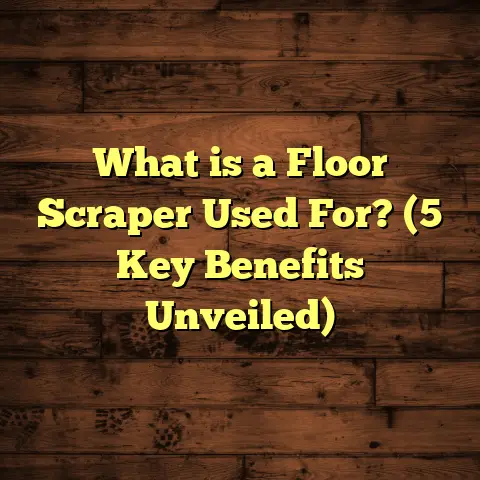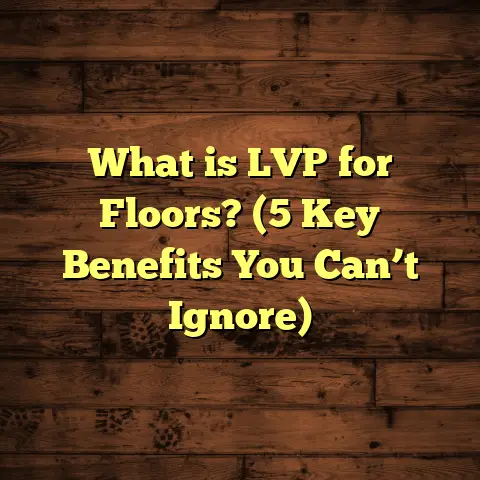What is a Finished Wood Floor? (7 Essential Benefits Revealed)
I remember the moment I first stepped onto a finished wood floor I had just installed in my own home. It was like walking on a smooth, warm surface that immediately transformed the whole room. The glow and feel were incredible. If you’ve ever wondered what exactly a finished wood floor is and whether it’s a good fit for your home, you’re in the right place. I’ll share everything I’ve learned through years of experience and research — including some stories from my projects and useful data that can help you decide confidently.
What is a Finished Wood Floor?
At its simplest, a finished wood floor is hardwood flooring that comes pre-finished from the factory. This means the wood planks or strips have been sanded, stained if desired, and coated with protective layers of finish before they arrive at your home or job site. You don’t have to sand or finish them after installation — they’re ready to use immediately.
This contrasts with unfinished wood floors, which are raw wood planks installed first and then sanded and finished on-site. Unfinished floors require more labor and time after installation since you have to apply stain, multiple coats of finish, and wait for drying between each step.
The finishing process at the factory uses advanced equipment that applies consistent layers of durable coatings such as polyurethane or aluminum oxide. These finishes not only enhance the beauty of the wood by bringing out natural grain patterns and colors but also protect the surface from scratches, moisture, and wear.
I’ve installed both types over the years, and I’ll walk you through why I often recommend finished wood floors for most homeowners. But first, let me share a little background about how these floors are made.
How Finished Wood Floors Are Made
Factory finishing involves multiple steps carried out in a controlled environment:
- Sanding: The raw wood is sanded smooth using industrial machines.
- Staining (Optional): Wood can be stained to create different colors or enhance natural tones.
- Sealing: A sealant layer helps protect the wood from moisture.
- Finishing Coats: Multiple layers of finish are applied. This can be water-based or oil-based polyurethane, or tough coatings like aluminum oxide.
- Curing: The finish is cured under UV light or through chemical processes to harden quickly.
- Quality Control: Each plank is inspected for defects, finish uniformity, and durability.
Because this process takes place in factories with specialized tools, the finish tends to be more uniform and durable than those applied at home.
Why Do Finished Wood Floors Matter?
When I first started in flooring installation, I thought all wood floors were basically the same. That changed after my first big job with unfinished hardwood. The sanding dust was everywhere — on furniture, air vents, even in the air for days. It was exhausting and messy.
Then I installed a finished wood floor for another client. No sanding dust, no strong chemical smells from fresh stain or finish drying. It was quick, clean, and efficient. The client was thrilled they could walk on their new floor right away without waiting weeks.
These experiences made me realize that choosing finished wood floors isn’t just about aesthetics—it’s about saving time, reducing hassle, and getting a long-lasting product.
The 7 Essential Benefits of Finished Wood Floors
Let me break down the key advantages of finished wood floors based on my hands-on work and some interesting data I’ve gathered over the years.
1. Faster Installation Saves Time and Money
One of the biggest benefits I notice immediately with finished wood floors is how much faster installation goes. Since there’s no need for sanding or finishing on-site, installers can focus purely on laying down the planks.
For example, for a 1,000 square foot area:
- An unfinished floor might take 5-7 days to install, sand, stain, finish multiple coats, and allow drying time.
- A finished floor can be installed in 2-3 days with immediate usability.
This speed translates into lower labor costs because installers spend less time onsite. Less disruption means homeowners can return to normal life quickly without living among dust or fumes.
In my own home renovation, switching from unfinished to finished flooring cut my project timeline in half — which felt like an instant win.
2. Cleaner Installation With No Dust
Sanding raw wood floors produces tons of fine dust particles. That dust settles everywhere—it’s a nightmare for anyone sensitive to dust or allergies.
I once worked on a project where we had to do extensive sanding for an unfinished floor in a home that had small children and pets. Even with dust barriers and air scrubbers, dust still spread into other rooms.
Finished wood floors eliminate this problem because all sanding happens off-site in specialized factories. When installers bring pre-finished planks to your home, there’s no sanding required at all.
This cleaner installation process means better indoor air quality during renovation—a major plus many clients appreciate.
3. Superior Factory Finish Quality
Since finishing happens under controlled factory conditions with commercial-grade equipment, factory finishes are typically more durable and consistent than those applied on-site.
Many factory-applied finishes use aluminum oxide—a compound harder than steel that resists scratches and wear incredibly well.
According to the National Wood Flooring Association (NWFA), floors with aluminum oxide finishes last up to 50% longer before needing refinishing compared to site-finished polyurethane floors.
In one client’s office space where foot traffic was heavy daily, their finished oak floor maintained its appearance after over five years without refinishing—a testament to factory finish durability.
4. Extensive Choices in Style and Texture
Finished wood floors come in an amazing range of species—oak, maple, hickory, walnut—and countless stains and textures.
You can find everything from smooth European oak planks with matte finishes to hand-scraped distressed hickory that feels rustic and natural.
I helped a client pick Brazilian cherry with a high-gloss finish for their dining room last year. The rich red tones complemented their decor perfectly. Another client loved wire-brushed maple for its vintage look but wanted the convenience of a finished floor.
Because manufacturers produce so many options with factory finishes, you get consistent color and texture across batches—a big advantage if you want uniformity in large spaces.
5. Easier Maintenance Over Time
Maintaining finished wood floors is straightforward because the factory finish seals the wood tightly against moisture and dirt penetration.
Daily sweeping or vacuuming keeps grit away that can cause scratches. Occasional damp mopping with manufacturer-recommended cleaners removes stains without damaging finish layers.
If minor scratches appear after years of use, many floors can be lightly screened (buffed) and recoated without full sanding.
I once advised a client who was worried about pet scratches on their finished maple floor—after three years, gentle buffing restored its shine perfectly without needing replacement planks.
6. Cost Savings Over Project Life Cycle
While pre-finished hardwood may cost slightly more upfront than raw wood flooring, it usually saves money overall once you factor in labor costs and finishing materials avoided during installation.
Using FloorTally has been a game changer for me here. This tool lets me input exact room dimensions alongside local labor rates and materials pricing to generate accurate budgets quickly.
For example, FloorTally showed me that while the material cost for pre-finished oak was about 10-15% higher per square foot compared to unfinished oak, total project costs ended up being 20-30% lower due to faster installation and no finishing needed onsite.
By planning budgets this way early on, I help clients avoid surprises or compromises later in the project.
7. Immediate Use After Installation
One thing clients love is that once finished wood floors are installed, you can walk on them immediately—no waiting days for finishes to dry or cure like with unfinished floors.
This is especially helpful when renovating lived-in homes where moving out isn’t an option or commercial properties needing quick tenant turnover.
I remember a café owner who couldn’t afford downtime between tenants—the quick installation of pre-finished flooring allowed them to reopen just days after flooring replacement instead of waiting weeks.
Real-Life Stories From My Flooring Projects
Story 1: The Allergy-Sensitive Family
A family with two young kids who suffered from asthma wanted new floors but dreaded dusty installations. We chose pre-finished maple flooring for their entire main floor.
During installation day, they were amazed how quiet and clean everything was compared to previous renovations they’d done elsewhere. No sanding dust meant their kids didn’t suffer from breathing issues afterward.
They told me months later they still loved how warm the floor felt but appreciated even more how hassle-free installation had been.
Story 2: The Busy Commercial Office
An office needed new floors but could only shut down over a weekend due to tight schedules. We installed engineered hardwood with factory finish over two days while staff stayed home.
The firm reopened Monday morning with brand-new floors that looked flawless—no mess, no odor complaints—helping them avoid costly business downtime.
Deeper Look: Durability & Finish Types Explained
Understanding finishes helps you pick the best option for your lifestyle:
- Aluminum Oxide: One of the hardest coatings available, it bonds chemically with wood fibers for lasting protection. Common on pre-finished floors.
- Oil-Based Polyurethane: Classic finish offering warm amber tones but takes longer to dry; prone to yellowing over time.
- Water-Based Polyurethane: Clearer finish that dries faster with less odor; often used on lighter woods.
- UV-Cured Finishes: Cured instantly under ultraviolet light; very hard and scratch resistant but usually only found in factory finishes.
- Wax Finishes: Mostly obsolete now due to maintenance challenges but provide natural sheen originally.
Most finished wood floors today use aluminum oxide or water-based polyurethane because they combine durability with ease of maintenance.
How Finished Wood Floors Stack Up Against Alternatives
People often compare finished hardwood with other popular choices:
| Flooring Type | Durability | Appearance | Maintenance | Cost Range Per Sq Ft |
|---|---|---|---|---|
| Finished Hardwood | High (20+ years) | Natural grain | Moderate cleaning | $7 – $17 |
| Laminate Flooring | Medium (10-15 yrs) | Imitation wood | Easy cleaning | $2 – $6 |
| Vinyl Plank Flooring | Medium (10-20 yrs) | Good variety | Very easy | $3 – $8 |
| Unfinished Hardwood | High (20+ years) | Natural grain | Requires refinishing | $5 – $12 |
Finished hardwood offers longevity that beats laminate easily while delivering real wood beauty unmatched by synthetic options.
Cost Breakdown & Budgeting Tips From My Experience
Here’s an expanded look at typical costs using data from recent projects combined with FloorTally estimates:
| Wood Species | Material Cost/sq ft | Labor Cost/sq ft | Total Cost/sq ft |
|---|---|---|---|
| Red Oak | $4 – $7 | $3 – $5 | $7 – $12 |
| Hickory | $5 – $8 | $3 – $6 | $8 – $14 |
| Walnut | $6 – $10 | $4 – $7 | $10 – $17 |
| Maple | $4 – $7 | $3 – $5 | $7 – $12 |
Tips:
- Add 5-10% extra material for cuts/waste.
- Consider subfloor condition—replacement or leveling adds cost.
- Include delivery fees if ordering specialty woods.
- Factor in removal cost if replacing existing flooring.
- Use tools like FloorTally early on for realistic budgeting tailored to your location.
Installation Insights From My Toolbox
Here are some practical pointers I share with clients:
- Acclimate Wood: Let flooring sit in the room for 48+ hours before installation so it adjusts to humidity—prevents warping later.
- Subfloor Prep: Ensure subfloor is clean, dry, level; this supports proper adhesion or nailing.
- Expansion Gaps: Leave gaps around walls per manufacturer specs as wood expands/contracts.
- Underlayment: Use cushioning underlayment if recommended for noise reduction or moisture barrier.
- Professional Help: Hire experienced installers familiar with finished wood products to avoid damage or improper fastening.
What Happens If Damage Occurs?
Even the toughest finishes can get scratched or dented over years. Here’s how you handle it:
- Light surface scratches can often be buffed out or repaired using colored wax sticks matching your floor color.
- Duller finishes benefit from occasional screening (light sanding with mesh pads) followed by re-coating.
- Deep gouges might require plank replacement but this is less common with durable finishes.
Remember: preventive care like using felt pads under furniture legs helps avoid damage long-term.
Final Thoughts From My Flooring Journey
Choosing finished wood floors has been one of the best decisions I’ve made in my career—and personally—because they balance beauty with practical benefits like speed and durability perfectly.
The combination of factory-applied tough finishes, broad style options, and cleaner installation makes them ideal for most homeowners looking to upgrade their spaces without headaches.
If you want a floor that looks great day one and stays beautiful for decades while saving time during installation—finished wood floors should definitely be on your shortlist.
Feel free to reach out if you want advice tailored to your project—I’ve walked thousands of feet of these floors and love helping others enjoy them too!





